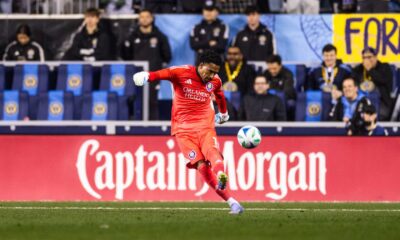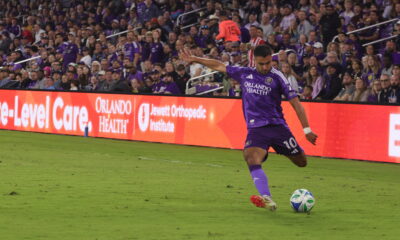Orlando City
Orlando City vs. Inter Miami: Player Grades and Man of the Match

After a lengthy weather delay, Orlando City battled with Inter Miami and won 1-0 thanks to an own goal from Damion Lowe. The shutout was a nice response from Orlando’s defense after conceding five goals to D.C. United earlier this week. All three of Orlando’s Designated Players started, but the offense had a hard time against Miami. Let’s dive into how each individual Lion performed in this win at Exploria Stadium.
Starters
GK, Pedro Gallese, 6.5 — His first and only save of the match was a huge one, making himself big and blocking a shot from Indiana Vassilev with his face in the seventh minute. It was a crucial stop to ensure Orlando didn’t fall into an early hole like it did Monday night. The rest of the night was fairly quiet for Gallese beyond coming out to collect dangerous balls from Miami into the box. His distribution was stellar, completing all but one of his 17 passes for a 94.1% success rate and connecting on four of his five long balls. This clean sheet was Gallese’s seventh of the year and first since May 14.
D, Kyle Smith, 6 — Playing at left back, Smith struggled at times to contain both DeAndre Yedlin and Vassilev. He wasn’t able to recover quickly enough after a turnover, leading to Vassilev’s shot on Gallese at point-blank range early in the match. He settled in a bit and received some help from Benji Michel to help keep Yedlin in check. Smith played every minute of the match and finished with two interceptions, a tackle, and a clearance. He also won three of his four aerial duels. Only one of his three attempted crosses connected, but it was a key pass that found Tesho Akindele late in the match. None of his four long balls were successful and he completed 83.9% of his 56 passes. The versatile defender has played everywhere along the back line this year, so let’s not forget he’s naturally a right back and is often playing out of position to fill gaps. After a rough game on Monday, this was a nice, albeit unspectacular, response from Smith.
D, Rodrigo Schlegel, 7 — The Argentine defender’s 88 touches were tied with Robin Jansson for the most on the team. The pair of center backs did well rotating the ball around so that Orlando could find new ways to attack. While he was only successful on one of his five long ball attempts, he did complete 90.5% of his 74 passes. He was solid on defense, contributing four clearances, three tackles, three interceptions, and two blocked shots. His tenacity helped him chase down attackers who got past him and step up and challenge players before they could make a play.
D, Robin Jansson, 7 — With Miami putting pressure on the team’s playmakers, Jansson completed 11 of his 16 long balls to help spark things on offense. The center back led the Lions with 75 passes, completing 88% of them, and contributed a key pass to break Miami’s lines and find Pereyra. His six clearances and three interceptions helped stop Miami in its tracks and he blocked a shot as well. It was a strong performance from the defender and he did it all without committing a foul or being booked for dissent.
D, Ruan, 6.5 — The right back was sprinting up and down his side of the field all night long and looked like the key to unlocking Miami’s defense in the second half. Ruan led the Lions with three key passes, using his speed to beat Christopher McVey and set up most of Orlando’s best chances. He should have had an assist after fizzing a ball in front of goal, but Michel couldn’t get his shot in the back of the net. Ruan made a nice run after a long series of possession from Orlando and got his head to the ball in the box, but Callender caught his attempt to center it. Both of his long balls were accurate and he was successful on 82.9% of his 41 passes as well. His quickness made him an asset in transition, but he could’ve done better during those opportunities with some better awareness to find an open teammate. His four unstable touches didn’t help matters on offense. Still, he was Orlando’s best weapon on offense. Ruan also showed plenty of hustle and had two tackles, even if his one-on-one defending could use some work.
MF, Cesar Araujo, 7.5 (MotM) — Araujo did a great job lending support on defense and frustrating opponents, leading Orlando with eight tackles and winning nine fouls. His role in the midfield was critical as he snuffed out plenty of Miami’s chances on the counter and hustled from start to finish. If Miami had the ball on Orlando’s side of the field, Araujo was usually there winning the ball back for his team. His passing could have been a bit better at times, but completing 83.7% of 49 passes isn’t terrible by any means and he had a key pass by finding Junior Urso in a dangerous spot at the top of the box. The 21-year-old is our Man of the Match for stopping Miami’s offense in transition and giving the midfield a needed edge.
MF, Junior Urso, 6.5 — The Bear had two shots and they were decent efforts. The first came in the first half and was blocked before going out for an Orlando corner. The second came after some great footwork to set up the shot, but Urso slipped on the wet field before shooting and couldn’t get it on frame. Urso saw plenty of the ball, playing every minute of the game and finishing with 75 touches and 63 passes at a strong 90.5% success rate. While he didn’t have a key pass or a cross, five of his six long balls found their target. He hasn’t scored in league play since March, but he did a good job setting up opportunities for himself to change that in this match.
MF, Mauricio Pereyra, 5.5 — Miami’s game plan was to smother Pereyra with constant pressure whenever the ball was in his vicinity and foul when needed. Lowe often came out to challenge him no matter how deep in the midfield Pereyra received the ball. He had a few miscues early on and made some uncharacteristic mistakes, including a bad giveaway that sent Vassilev in on goal. Pereyra’s only shot of the match was sent into orbit. He settled in a bit in the second half and finished with 41 passes at an 80.5% success rate. Pereyra had two key passes, a successful long ball, and one of his two crosses was accurate. He also contributed two tackles and a clearance to help out defensively.
MF, Benji Michel, 5 — In his 100th appearance as a Lion, Michel played on the left wing and contended with Deandre Yedlin throughout the match. Yedlin was aggressive on that side of the field and Michel often dropped back to help the back line deal with him. Michel had a golden opportunity to score in the 58th minute as he crashed the box and got on the end of a cross from Ruan, only to send the shot directly at Drake Callender. It was Michel’s only shot of the match and Orlando’s only shot on target. His only cross was unsuccessful, although he did a solid job beating his defender and whipping the ball into the box with his weak foot. He only had 20 touches and 11 passes at an 81.8% success rate in 69 minutes of action before being subbed off for Jake Mulraney. Time and time again, Orlando’s possession ended because of Michel losing possession and he finished with five unstable touches.
MF, Facundo Torres, 6.5 — The statistics won’t reflect just how active Torres was in this match. On offense, Torres worked hard to make sure he was an outlet for passes, constantly made runs to try unlocking the defense, and had his head on a swivel with the ball at his feet to find the open man. His two shots were tied for a team high, although neither ended up on target. The 22-year-old completed all but four of his 36 passes for a strong 88.9% completion rate. His only cross missed its mark and he didn’t have any key passes, but his one long ball was accurate. Torres supplied plenty of defensive pressure from start to finish and had two tackles. He wasn’t able to bend the game to his will and have the kind of performance needed to break the game wide open, but it was still a solid outing from the Designated Player.
F, Ercan Kara, 5.5 — It was a quiet night for the Austrian forward as he wasn’t able to make much of an impact. Kara didn’t receive much service due to Miami’s defensive pressure on Orlando’s playmakers and a lack of crossing from the wings while he was on the field. He also didn’t have any aerial duels at all in the match, although he did have a clearance during one of Miami’s corner kicks. Regardless of the service, Kara needed to find ways to get involved while the team hunted for a goal. It was the first time this season that Kara started a match and didn’t record a shot. He only had 14 touches and completed eight of his 11 passes for a 72.7% success rate before coming off in the 68th minute.
Substitutes
F, Tesho Akindele (68’), 6 — The Canadian forward made some nice runs in the lead up to his first shot of the match. Akindele made a well-timed dash out wide to receive the ball in space and then held up play for Torres and Ruan to catch up and set up a shot for him that he sent wide. His second shot was a headed effort from a good cross by Smith that Akindele couldn’t make clean contact on. He had seven touches, completed one of his two passes, contributed a tackle, and won both of his aerial duels. The 30-year-old is still on the hunt for his first goal this year, but he did well coming off the bench to use fresh legs and his size to win the ball up the field.
MF, Jake Mulraney (69’), 6.5 — Mulraney’s only cross of the match was technically unsuccessful, but it resulted in the lone goal of the match. The Irishman’s cross in stoppage shouldn’t have caused any problems for Miami, but Lowe’s desperate attempt to clear it resulted in an own goal. It’s hard to give Mulraney much credit, but plays like that can’t happen unless the ball is put into the box. Mulraney had nine touches and completed all seven of his passes. It was his first time coming off the bench since May, with Michel getting the start on the wing opposite Torres.
F, Alexandre Pato (78’), N/A — Pato came on for Pereyra late in the match and had five touches, all in the opposing half. He completed two of his three passes, including a nice headed pass to lay the ball off to Urso that eventually led to Mulraney’s cross and the own goal. There weren’t any flashes of brilliance after coming off the bench from Pato in this one as he had no shots or key passes.
D, Michael Halliday (86’), N/A — The 19-year-old came on late and had nine touches while completing all five of his passes. His only cross could’ve been better, but it came after he won the ball in the air and dribbled down the wing himself. After the own goal, Halliday did his part to kill off the game. Halliday looked good when on the ball in this one and a congested schedule this month could mean more minutes for him in the near future.
That’s how I saw each player’s performance in Orlando’s home win over Inter Miami. Make sure to let us know your thoughts in the comments below and vote for your Man of the Match.
Polling Closed
| Player | Votes |
| Cesar Araujo | 51 |
| Rodrigo Schlegel | 5 |
| Robin Jansson | 6 |
| Ruan | 0 |
| Other (Let us know who in the comments) | 2 |
Orlando City
Intelligence Report: Orlando City vs. New York Red Bulls
Get caught up on how things have been going for the New York Red Bulls, courtesy of someone who knows them best.

Happy Friday, everyone! Another Orlando City match is upon us, and with it comes a chance for the Lions to extend their unbeaten run to five games on the bounce. To do so, they’ll need to equal or better the result they got earlier in the season against the New York Red Bulls in the first game between the two sides, which finished in a 2-2 draw.
A visit from the Red Bulls means that I spoke to Mark Fishkin, who hosts the always excellent Seeing Red Podcast. As usual, Mark was helpful in bringing us up to speed on how things have gone for the Red Bulls since these two teams last met.
New York has been one of the better defensive teams in the league. They’ve only given up seven goals in seven games and have kept two clean sheets. What’s been the key to the good defensive start?
Mark Fishkin: Formation and experience. RBNY has mostly played this season in a 3-4-3 with newcomer and Bundesliga vet Alexander Hack as one of the three centerbacks, and he’s been (mostly) solid. The wingbacks offer a ton of help defending. An in-form Carlos Coronel has single-handedly kept NY in games with quick-reaction saves as well.
Like Orlando City, the Red Bulls are currently hovering around the midtable of the Eastern Conference with a 3-2-2 record and 11 points. What needs to happen for this team to make the leap from being a good team in the East, to a great one?
MF: Given both teams are only four points off the top of the East, it’s evident that there’s a ton of quality sides right now for this early in the season. Both teams have points in five of seven games, and without a last-second PK at the Revs, New York would be (slightly) higher. More clinical finishing is needed for the Red Bulls to enter the elite MLS tier.
Aside from the big names of Erik Choupo-Moting and Emil Forsberg, who is a guy that we should have our eyes on come Saturday afternoon?
MF: Young players Omar Valencia, New York’s Panamanian international left back, who made the MLS Team of the Week bench with stellar defensive play and a game-winning assist, and Serge Ngoma, an RBNY Homegrown winger who is back after 18 months of injuries — who headed in Valencia’s cross last week to beat Chicago. On a team that added experience in the off-season, these young players delivered a jolt into the New York attack.
Will any players be unavailable due to injury, suspension, etc.? What is your projected starting XI and score prediction?
MF: Lewis Morgan continues to rehab from knee surgery, but if RBNY plays in a 4-2-2-2, the lineup could look like:
Carlos Coronel; Dylan Nealis, Noah Eile, Tim Parker, Omar Valencia; Felipe Carballo, Daniel Edelman; Serge Ngoma, Emil Forsberg; Erik Choupo-Moting, Mohammed Sofo.
The Red Bulls have played to the level of their opponents for a month now. Saturday afternoon is no different. Another 2-2 draw is in order.
Thank you to Mark for helping us get caught up on the Red Bulls. Vamos Orlando!

Lion Links
Lion Links: 4/11/25
Orlando City prepares for the New York Red Bulls, storylines for the Orlando Pride’s road game, Orlando’s U-18 team highlighted, and more.
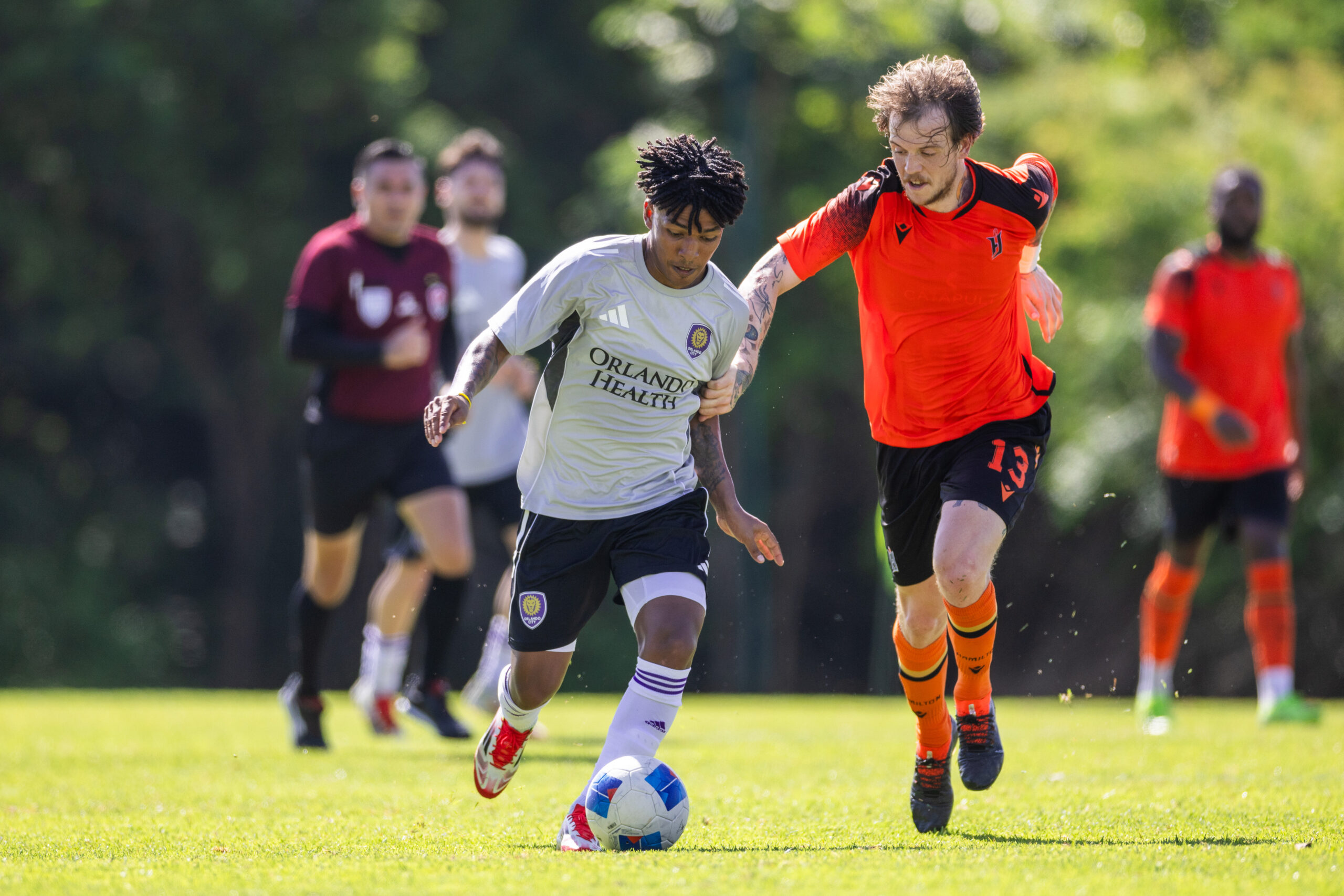
Happy Friday, Mane Landers! It’s been a bit of a long week for me, but I was able to get some reading done on a pair of books I’ve been meaning to scratch off my list. I don’t have many plans this weekend beyond working, enjoying soccer, and putting my wok through its paces while I try making dan dan noodles for the first time. Fingers crossed. For now though, let’s dive into today’s links from around the soccer world!
Orlando City Hosts the New York Red Bulls On Saturday
The Lions will welcome the New York Red Bulls to Inter&Co Stadium Saturday at 4:30 p.m. in another rematch of last year’s Eastern Conference final. It’s already the second meeting between the two teams this season, with them drawing 2-2 at Sports Illustrated Stadium on March 15. Both teams have 11 points from seven games this season, although the Red Bulls are still on the hunt for their first road win. Orlando City Head Coach Oscar Pareja spoke about how the team will look to carry momentum from a tough match in Philadelphia into this game against a Red Bulls team that boasts an intense press and an offense led by Emil Forsberg.
Storylines Heading Into Orlando Pride Road Game
The Orlando Pride are back in action Saturday at 7:30 p.m. in a road game against the Seattle Reign, and there’s plenty to watch for. Unbeaten so far, the Pride have the chance to become the fourth team in league history to start the season with four straight wins. Orlando’s defense has been stellar, but Seattle is a tough environment and the Reign scored multiple goals in both games against the Pride last year. For the Reign, this game is a chance for a statement win at home against the defending champs with young players like Jordyn Bugg and Maddie Dahlien leading the charge.
Orlando City’s U-18 Team One to Watch This Weekend
The Generation Adidas Cup kicks off this weekend at IMG Academy in Bradenton and Orlando City’s U-18 squad was noted as one to keep an eye on in the tournament. Orlando won 21 of its 27 games this season. Travis Clark of MLSSoccer.com touted players like Colin Guske and Gustavo Caraballo for powering the offense. Clovis Archange was one of three defenders named to this year’s Rising XI and is joined on the back line by Jackson Platts. Orlando will take on Inter Milan Saturday at 4:30 p.m. in its first game, with LAFC and the Columbus Crew as the other two teams in the group.
2025 Concacaf Gold Cup Groups Are Set
The draw for this summer’s Concacaf Gold Cup is complete and the United States Men’s National Team will square off against Saudi Arabia, Haiti, and Trinidad & Tobago in group play. Saudi Arabia is the lone guest nation of the tournament and could give the U.S. a tough match when the two nations square off. The USMNT will have plenty of eyes on it for this tournament, especially after falling on its face in the Concacaf Nations League in March.
As for the other groups, Mexico was drawn against Costa Rica, Suriname, and the Dominican Republic in Group A, while Canada will take on Honduras, El Salvador, and Curacao in Group B. Group C will feature Panama, Jamaica, Guatemala, and Guadeloupe.
Free Kicks
- The MLS Board of Governors authorized further exploration into moving the league’s calendar to mirror the international one that runs from fall to spring. As a result, that possible change can’t happen until 2027 at the earliest.
- In case you missed it late Wednesday night, enjoy Tristan Blackmon’s goal that booked the Vancouver Whitecaps their spot in the Concacaf Champions Cup semifinals. They’ll face Inter Miami, with the winner taking on whichever team advances between Tigres and Cruz Azul.
- Denver’s NWSL team hired Jen Millet as its first president. Millet will be in charge of all business operations and joins after time as Bay FC’s chief operating officer.
- According to a report from Japanese sports newspaper Sponichi, the USMNT will host Japan for a friendly on Sept. 6 in San Diego.
- Manchester United goalkeeper Andre Onana had a game to forget in his team’s 2-2 draw against Lyon in the Europa League, as he spilled the ball that resulted in Lyon’s late equalizer. Despite the mistakes, United Head Coach Ruben Amorim reiterated the confidence he has in his goalkeeper.
- CONMEBOL President Alejandro Dominguez made an official proposal to expand the 2030 World Cup to 64 teams for the centennial edition of the tournament.
That’s all I have for you this time around. I hope you all have a fantastic Friday and rest of your weekend!
Orlando City
Orlando City’s Usage Rate and Shot Creation Through Seven Games
An analysis of Orlando City’s usage and shot-creation rates and a comparison of their top performers to the rest of MLS.
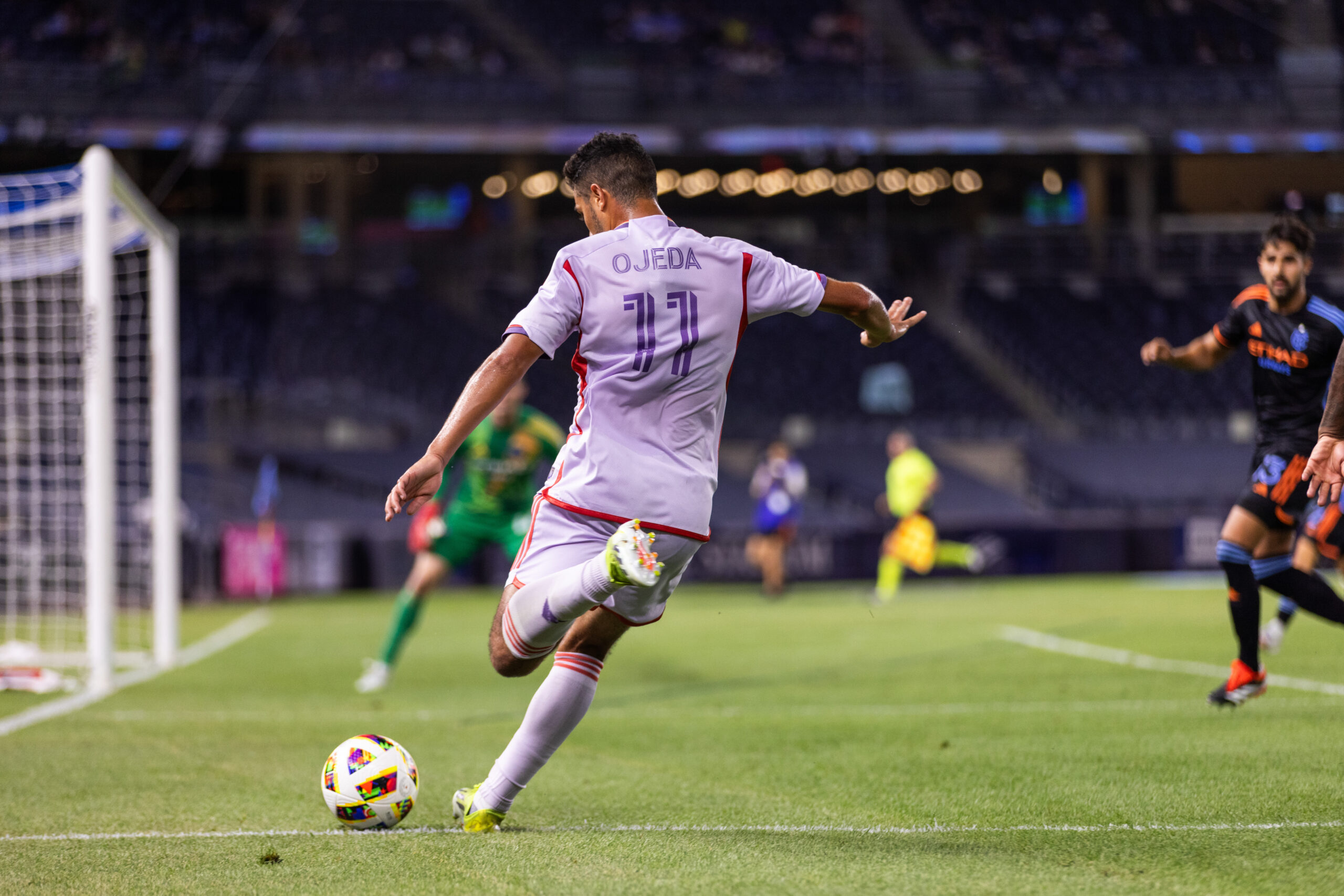
As so often happens in articles about soccer, I am going to open by writing about…not soccer. The NBA regular season is in its final days, and so a lot of the discourse on podcasts or TV shows about basketball is about who deserves what awards for the 2024-2025 season. This is not the place for that discussion, though I do think my son’s favorite Orlando Magic player, Paolo Banchero, has had a great season. What I want to explore as it relates to basketball awards is how the concept of “usage” plays a big role when comparing players against one another.
Usage in basketball is essentially a measure of what percent of a team’s possessions were finished by a given player, whether it was via a shot, turnover, or offensive foul. There are different formulas for usage, as some get even more intricate as it relates to the definition of a possession, but we are going to change the subject to soccer momentarily so let’s not dwell on the basketball metric any longer than necessary. The critical part of usage is that it is easier to put up scoring numbers — the numbers fans often default to when evaluating who are the best players, when you have a much higher usage rate. If most possessions end with the ball in your hands, then the offense is likely designed around you, and the opportunities will be there for more baskets.
In soccer, usage can be looked at similarly, with goals instead of baskets, and I will draw on the work of several other authors in how they have calculated usage, or, as they often refer to it, possession-ending actions. In soccer it is similar to basketball, but we will get more nuanced with the definition. Here are the possession-ending actions I used, with all data coming from Opta’s tracking on fbref.com:
- Shots
- Incomplete passes
- Failed Ttake-ons
- Dispossessions
- Miscontrols
I looked at this data in two ways: first by normalizing the data by taking the total number of possession-ending actions and calculating it on a per-90-minutes-played basis (PEA / 90) , and then also by taking a player’s possession-ending actions and dividing them by the total number of possession-ending actions for the whole team, to see their percentage (usage rate). Here is a look at Orlando City’s performance thus far this season (I’m only including field players who have played at least 300 minutes, but a quick shout out to Gustavo Caraballo for generating a PEA per 90 minutes of 40 in his nine minutes played thus far this season. Gustavo was really goosing the throttle when he had the ball. I’ll see myself out.):
| Player | Mins Played | PEA / 90 | Usage Rate |
|---|---|---|---|
| Rodrigo Schlegel | 630 | 7.3 | 5.5% |
| Alex Freeman | 575 | 15.2 | 10.5% |
| Martín Ojeda | 571 | 15.4 | 10.5% |
| Marco Pašalić | 550 | 15.4 | 10.2% |
| Iván Angulo | 523 | 12.9 | 8.1% |
| Eduard Atuesta | 514 | 16.1 | 9.9% |
| Luis Muriel | 490 | 16.3 | 9.5% |
| César Araujo | 450 | 5.6 | 3.0% |
| Robin Jansson | 450 | 6.6 | 3.6% |
| Rafael Santos | 420 | 18.5 | 9.4% |
It is nice when data backs up the eye test, and the eye test thus far this season definitely shows that Cesar Araujo, Robin Jansson, and Rodrigo Schlegel play conservative soccer, which is critical being that they generally possess the ball in the center of the field near their own goal, whereas the attacking players and the fullbacks are much more likely to be trying to create something on offense, and therefore ending a possession.
I was a little surprised to see Rafael Santos as the player who is ending the most possessions on a per-90-minute basis, but he is someone who is constantly looking to switch the field or play in a cross, and those are low-probability passes that have a low completion rate, meaning they often end a possession.
Usage rate depends heavily on minutes played, as despite the name, it has elements of a counting statistic in it, and it was not surprising to see the top three players in usage rate being non-central defenders who had played a lot of minutes. Santos is again high here because of his style of play, but as it appears that he may be fighting for his starting position, that number will likely drop over the next few games, unless he wins back the left back role.
As a quick aside, only one Orlando City player had a usage rate in double digits during MLS regular-season play in 2024, and as you may have guessed, that player was indeed Facundo Torres, with exactly 10%.
Usage rate is really a statistic that helps identify players who are trying to make something happen (shots, incomplete passes, failed take-ons, dispossessions) or who are targets for teammates trying to make something happen (miscontrols of a ball passed to them), but ultimately what is the most impactful when trying to make something happen is whether a shot gets created, because shots turn into goals, and that is how games are won. If we look at the same group of Lions and focus specifically on creating shots (shot-creating actions + shots taken), the story looks a little different in terms of where those come from:
| Player | Mins Played | Shots Created / 90 | Shots Created % |
|---|---|---|---|
| Rodrigo Schlegel | 630 | 1.0 | 2.4% |
| Alex Freeman | 575 | 4.2 | 9.4% |
| Martín Ojeda | 571 | 8.6 | 18.9% |
| Marco Pašalić | 550 | 5.7 | 12.2% |
| Iván Angulo | 523 | 3.1 | 6.3% |
| Eduard Atuesta | 514 | 6.0 | 11.9% |
| Luis Muriel | 490 | 7.0 | 13.3% |
| César Araujo | 450 | 2.8 | 4.9% |
| Robin Jansson | 450 | 0.2 | 0.3% |
| Rafael Santos | 420 | 3.8 | 6.3% |
Alex Freeman, Martin Ojeda and Marco Pašalić lead the way in usage rate, but they are closely grouped together, and Eduard Atuesta, Luis Muriel, and Santos were not too far behind. Ojeda is in a class by himself when it comes to creating shots though — significantly ahead of Muriel and Pašalić. Freeman is well ahead of his defensive teammates too, and if you look at the scatterplot below of all MLS defenders from 2024 and 2025, you can see that there are very few defenders who are as attack minded and who help create as high a percentage of their team’s shots as he does (Freeman’s 2025 season is in the purple bullseye, 2024 defenders played at least 500 minutes and 2025 defenders played at least 300 minutes):
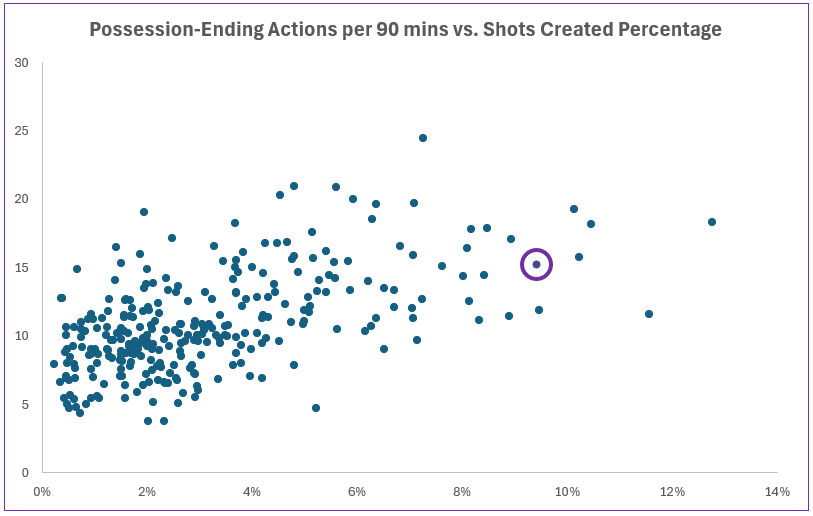
I know someone who was driving the Freeman bandwagon last year, and that person, who may or may not have written the words you are are reading right now, is pretty fired up about how much he is contributing for the Lions this season.
I mentioned earlier that Ojeda is well ahead of his teammates in 2025 in shot-creation percentage, but there are some other MLS players who are far more of a focal point of their team’s offense than he is. The below chart is formatted similarly (the y-axis is on the same scale but the x-axis is not, as attacking players generally create a much higher percentage of shots), and is for midfielders and strikers for for the 2024 and 2025 MLS seasons (Ojeda’s 2025 season is in the purple bullseye, and the same minimum minutes played requirements are in place):
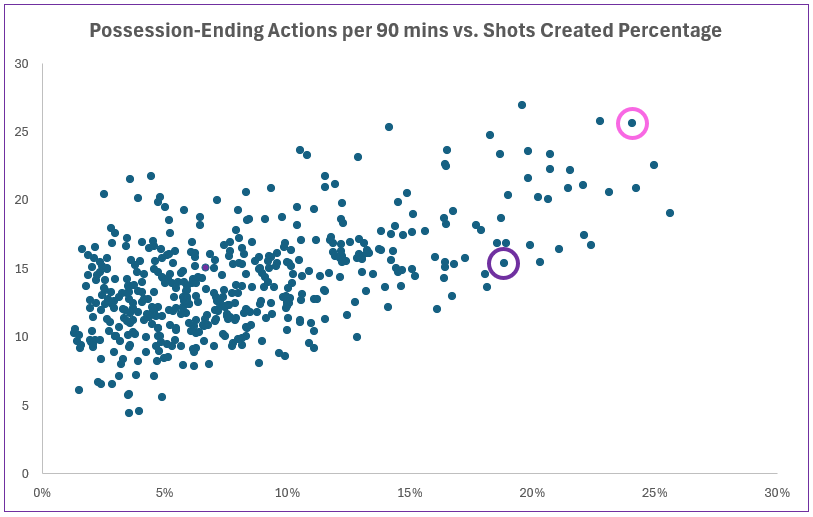
As you might have guessed from the pink bullseye, that is indeed Lionel Messi, with his 25.6 possession-ending actions per 90 minutes and 24% of his team’s shots created thus far this season. Messi’s metrics existing above and to the right of Ojeda’s on this chart is not an indication that he is better than Ojeda (although to be fair, he might be), but what it shows is that he initiates more attacking plays and is involved in more of Miami’s shots than Ojeda is in Orlando City’s.
The age-old quantity vs. quality conversation exists as it relates to looking at usage rate and the percentage of shots created by a player. Whether it be basketball or soccer, teams are not looking for players who create or take shots. They want players who will create and make shots. Taking on defenders every time you receive the ball or constantly trying to hit risky passes will increase the various counting and rate stats, but unless a player is successful with those take-ons and passes, what they will more likely get is a seat on the bench and a pause on accumulating any new stats.
I will be tracking the usage numbers throughout the season, and we will revisit them later in the year to see what has changed. With the return of Duncan McGuire to fitness, it will be interesting to see what that does to Ojeda’s usage if he starts to play more minutes out on the wing — and also to that of Muriel if he more frequently plays as the number 10 instead of playing as a striker. The insertion of David Brekalo into the starting lineup may unleash Freeman even more and evoke more comparisons to his wide receiver father as he flies up the sideline looking to receive a long bomb and turn it into a score.
In the end, the stats from this article are not ones that players will be trying to improve. They are more descriptive statistics that explain how the team — and particularly the offense — has interacted thus far this season. Usage rate may be important, but what is more important is that Orlando City gives the opposing net some serious usage in the match this weekend.
Vamos Orlando!
-
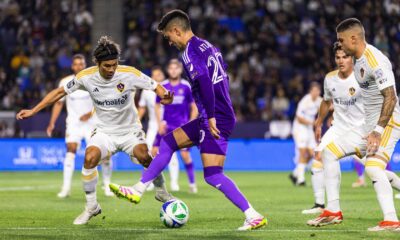
 Orlando City2 weeks ago
Orlando City2 weeks agoOrlando City vs. LA Galaxy: Final Score 2-1 as Cardiac Cats Score Late to Earn First Road Win
-

 Orlando Pride2 weeks ago
Orlando Pride2 weeks agoOrlando Pride vs. San Diego Wave FC: Preview, How to Watch, TV Info, Live Stream, Lineups, Match Thread, and More
-
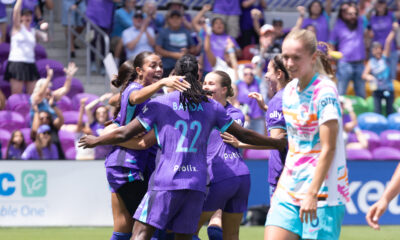
 Orlando Pride2 weeks ago
Orlando Pride2 weeks agoOrlando Pride vs. San Diego Wave FC: Final Score 2-1 as Pride Win Third Straight
-
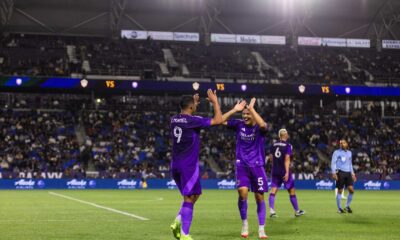
 Orlando City2 weeks ago
Orlando City2 weeks agoOrlando City vs. LA Galaxy: Five Takeaways
-

 Orlando City2 weeks ago
Orlando City2 weeks agoOrlando City vs. LA Galaxy: Preview, How to Watch, TV Info, Live Stream, Lineups, Match Thread, and More
-
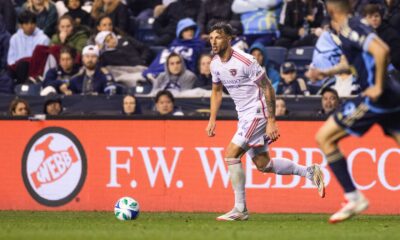
 Orlando City6 days ago
Orlando City6 days agoOrlando City vs. Philadelphia Union: Final Score 0-0 as Lions Extend Unbeaten Run to Four Games
-
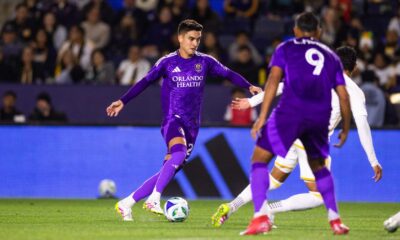
 Orlando City2 weeks ago
Orlando City2 weeks agoOrlando City vs. LA Galaxy: Player Grades and Man of the Match
-
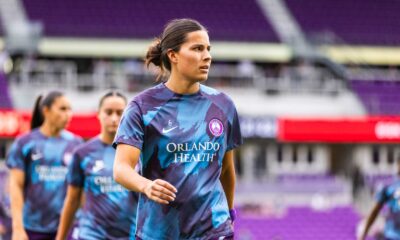
 Lion Links1 week ago
Lion Links1 week agoLion Links: 4/2/25


